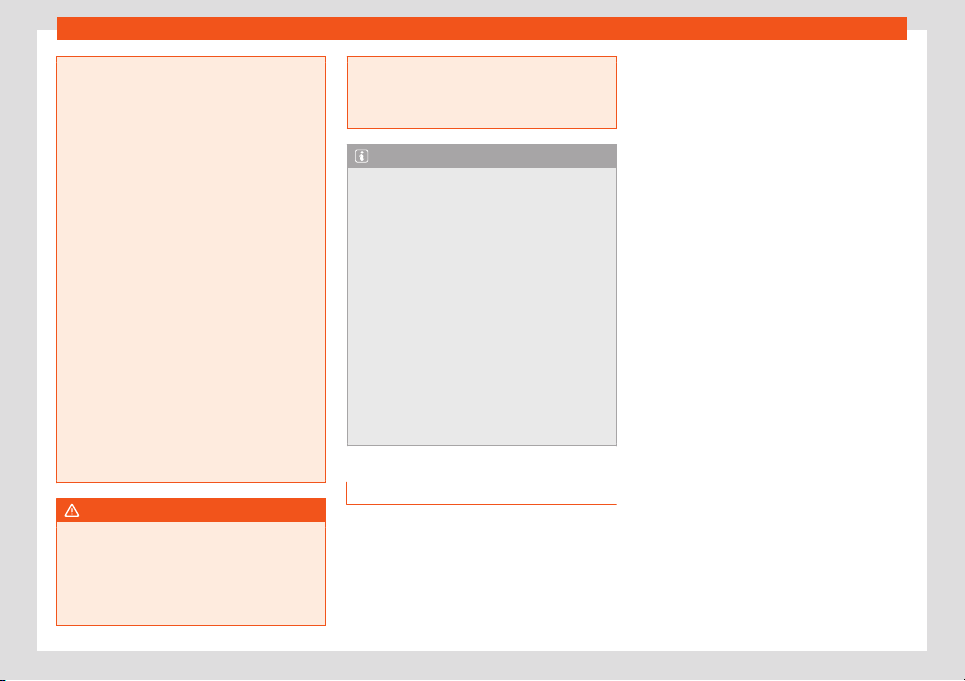Loading ...
Loading ...
Loading ...

Driving
●
Always secur
e loads correctly with suita-
ble and undamaged attachment rope or
straps.
●
Adjust your speed and driving style to vis-
ibility, road, traffic and weather conditions.
●
Trailers with a high centre of gravity can
overturn more easily than those with a low
centre of gravity.
●
Avoid brusque manoeuvres and sudden
braking.
●
Always take the following precautions
seriously.
●
Reduce your speed immediately if you
observe the trailer rocking from side to
side.
●
Never drive at more than 80 km/h
(50 mph) when towing a trailer (or 100
km/h [62 mph] in exceptional circumstan-
ces). This also applies in countries where
higher speeds are permitted. Always take
the speed limits for vehicles with and with-
out trailers in each country into account.
●
Never try to stop the “snaking” by in-
creasing speed.
WARNING
When driving with a trailer and using a tow
hitch that was not inst
alled by SEAT, the
Start-Stop function must be manually de-
activated. Otherwise, this could cause a
braking anomaly that could result in an ac-
cident with serious consequences.
●
Always manually deactiv
ate the Start-
Stop function when a trailer is being used
on a tow hitch that has not been installed
by SEAT.
Note
●
Al
ways t
urn off the anti-theft alarm sys-
tem before connecting or disconnecting a
trailer
›››
page 122. Otherwise, the tilt sen-
sor may erroneously activate the alarm.
●
Never use a trailer with a new engine (for
the first 1,000 km or 600 miles)
›››
page 311.
●
At SEAT, we recommend folding in the tow
hitch ball when a trailer is not being used.
In case of a rear collision, the damage
caused to the vehicle with the extended
tow hitch ball could be more extensive.
●
In some models, a tow hitch is necessary
for towing vehicles. For this reason, you
should store the tow hitch in the vehicle at
all times.
Technical requirements
If the car is supplied with a f
act
ory-fitt
ed
towing bracket it will already have the neces-
sary technical modifications and meet the
statutory requirements for towing a trailer.
Only use an approved tow hitch for the gross
trailer weight rating. The tow hitch must be
suitable for both the vehicle and trailer and
must be securely fitted to the vehicle chassis.
Only use a tow hitch with a removable ball
joint. Always check and take into account the
tow hitch manufacturer's instructions. Never
fit a trailer tow hitch “that distributes the load”
or “balances the load”.
Bumper mounted tow hitch
Never fit a tow hitch or its attachments to the
bumper. A tow hitch should never interfere
with the bumper performance. Do not modify
the exhaust system and brake system. Regu-
larly check the tow hitch to ensure it is firmly
fitted.
Engine cooling system
Driving with a trailer increases the load on the
engine and cooling system. The cooling sys-
tem should always have sufficient coolant
and to be able to cope with the vehicle and
trailer.
Electric trailer brake
If the trailer has its own braking system,
please note the relevant legal requirements.
The trailer braking system should never be
connected to the vehicle braking system.
Trailer cable
Always use a cable between the vehicle and
the trailer
›››
page 305.
302
Loading ...
Loading ...
Loading ...